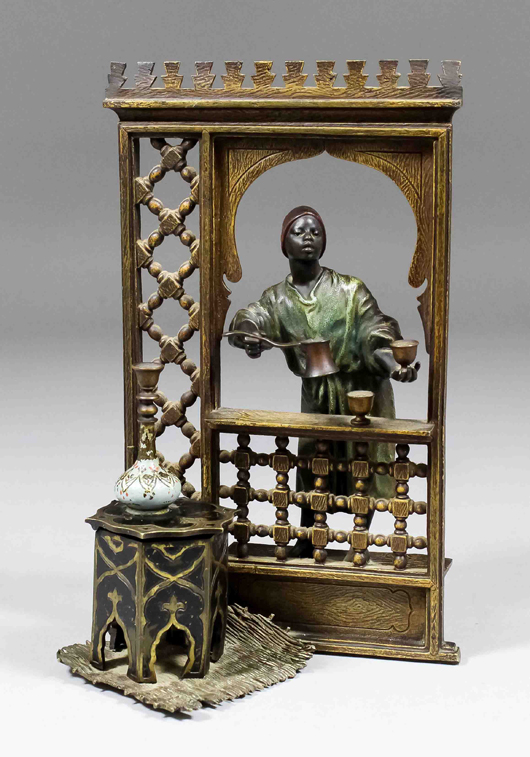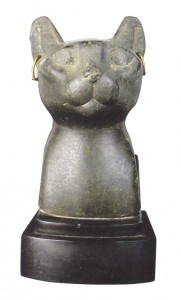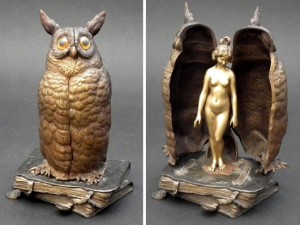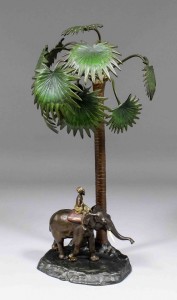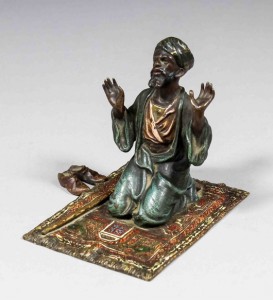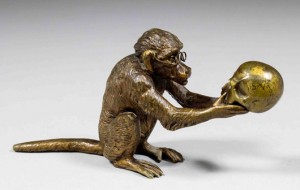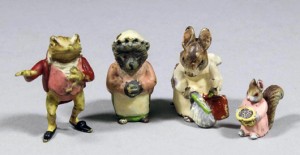LONDON – Do winters seem harder work the older we get? Somehow, it feels like it, but no worries, spring is pushing out the gray and with the clocks going back, car boot sales beckon.
The luckiest among us will uncover some priceless but long-forgotten antique or work of art that could change the life of the finder. Keep an eye out for bronze models of cats like the one illustrated below.
While not exactly a car boot find – the life-size Egyptian relic dated by the British Museum to 700-500 B.C. was discovered standing in front of a gas fire in a cottage in Cornwall – it’s sale certainly was a life-changer. It fetched a cool 52,000 pounds.
It reminded us of a car boot find we made last year and, ironically, it was another cat, although admittedly somewhat younger. The seller was certain it was made of lead and he reckoned it was a child’s plaything. The only thing lead about it was the paint used to decorate it.
In fact, it was a tiny cold-painted bronze model of a tabby, one of a host of models of animals, birds and other exotic creations made probably in one of the 50 or so Viennese foundries in business in the mid to late 19th century. Its value? In the saleroom, perhaps 60-80 pounds.
The Bronze Age began about 2,000 years before Christ. Since then, among other things, we’ve been spending it, fighting with it, cooking in it and decorating our homes with it.
An alloy of copper and tin, its properties make bronze ideally suited to casting: as it solidifies, it expands to fill every last intricate detail of a mold. On cooling, it then contracts slightly, making removal of the mold a simple process.
Famous sculptors have been attracted to such a perfect medium from antiquity to the present day, but for every one piece by a name that’s revered, there are thousands that collectors of modest means can acquire and enjoy.
Our personal favourite is Franz Xavier Bergman (1861-1936) probably the most famous of the Viennese sculptors who specialized in cold-painted bronzes. But first, let’s be clear of the difference between, say, our tabby cat and a bronze from antiquity.
The latter has a surface untouched by anything other than time. Over the centuries such pieces develop a patina caused by oxidation and are highly prized by connoisseur collectors who appreciate the effects produced by age (which is why cleaning them is such a specialized task).
The former are decorated with several layers of special, heavy lead-based polychrome paints, applied after objects are removed from the mold. Pieces decorated with enamels would normally be kiln-fired to melt the paint and ensure it has fused to the surface of the object to be decorated. Cold-painted bronzes are not subjected to the enameling process – they remain cold – relying on the standard of painting to dictate the quality of the finished item.
The technique was popular around the turn of the century and thousand upon thousand of the little animals and other figures, some as small as a few inches in height, poured out of Viennese foundries. Bergman’s manufactory was one of the leading makers.
It was founded by his father, also Franz (1838–1894) a professional metal chaser from Gablonz, in Austria, who came to Vienna in 1860. Franz Xavier inherited the business on his father’s retirement and opened a bigger, much more productive foundry there in 1900.
By no means all the animal figures came from Bergman’s works, but many did and sadly, many are unmarked. Those that are marked carry a capital “B” in a vase-shaped design, the presence of which removes any doubt as to the provenance.
Bergman was also a fan of the exotic, producing larger figures and groups. Some depict Arabs, perhaps selling colorfully painted carpets, riding camels or sitting in tents at an oasis complete with palm tree and water. Others are based on models from Bergman senior’s days.
More rare are those wired for electricity and fitted small lightbulbs to be used as table or bedside lamps. Being bigger objects, such pieces are more likely to carry the factory mark. Prices often run into four figures.
Bergman junior also had an eye for the erotic, fantasy pieces that today’s collectors covet most. Always featuring a naked or scantily clad young woman in sensuous pose, Edwardian bachelors no doubt delighted in showing them off to their friends. But they were subtle too.
The Arab selling a carpet, a model of an owl, a bear or some other unassuming object was constructed cleverly with a hidden button or lever which, when activated, causes the model to open, revealing the saucy secrets hidden inside. Expect to pay handsomely for such novelties.
They were no doubt pricey when they were new. Manufacturing them was also something of a risk for Bergman, but he covered his tracks by marking them with the tradename “Nam Greb” to avoid upsetting his more conservative customers, and, perhaps, making them sound even more exotic.
The joy of cold-painted bronzes in general and those by Bergman in particular are the vibrant colors that remain so in the best examples. Whereby hangs the problem. Being unfired, the paint remains soft and, therefore vulnerable. Damage occurs easily and few examples are in mint condition. Those that are sell for a premium, while chips or wear reduces value considerably.
So do watch out for then at auctions and car boot sales. Bergman bronzes, particularly the small animal and bird models, are the easily overlooked and definitely not painted lead. Finding one could represent a cash windfall.
___
If you care at all for bronze, don’t ever polish it. Bronze is highly susceptible to corrosion – it turns dark brown or greenish brown when exposed to the atmosphere, but this is considered one of the metal’s wonderful attributes.
The surface color – or patina as it is called – should be protected at all costs. To do otherwise can have a seriously adverse affect on the value of a bronze object and will spoil its appeal possibly forever.
Under no circumstances should any metal polish be used and bronze should always be kept away from water. Instead, a light dusting is all that is required and perhaps careful rubbing with a clean cloth.
Avoid rubbing hard, particularly on raised parts where the patina could be worn away.
Dust in crevices can be removed with a cotton bud moistened with saliva. Dull patination can be revived with the sparing application of a microcrystalline wax.



